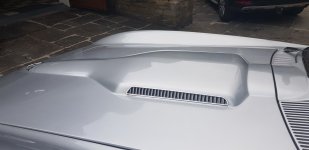You are using an out of date browser. It may not display this or other websites correctly.
You should upgrade or use an alternative browser.
You should upgrade or use an alternative browser.
Nice looking Vettes with Attitude here please
- Thread starter Daytona Vette
- Start date
Roscobbc
Moderator
Tyres are too narrow for rims selected which is the only way the tyre/wheel combo will fit under the flared fenders - presuming he has air/hydraulic suspension one needs to presume its at its lowest setting - so how much higher in 'normal' drive stance? 4" higher? - still think unless the suspension is rock hard and on limited movement the first really big and unseen bump in the road surface and those flares will rip-off........
Baron von Del Boy
Well-known user
Chuffer
CCCUK Member
Typical of the era , the fabulously styled Marcos GT was designed by Frank Costin , an ex De Havilland aerodynamics engineer . He just forgot that cars were not meant to take off .  My 1995 Mantara had a much re designed front end with a built in air dam but it still got worrying light on the steel as you nudged 100mph .
My 1995 Mantara had a much re designed front end with a built in air dam but it still got worrying light on the steel as you nudged 100mph . 


Baron von Del Boy
Well-known user
Baron von Del Boy
Well-known user
Roscobbc
Moderator
Early C3's ('68, '69) are particularly bad on front end lift - 120mph and the front end starts to become 'light' - 135 mph and it wants to become airborne........Typical of the era , the fabulously styled Marcos GT was designed by Frank Costin , an ex De Havilland aerodynamics engineer . He just forgot that cars were not meant to take off .My 1995 Mantara had a much re designed front end with a built in air dam but it still got worrying light on the steel as you nudged 100mph .
View attachment 11682
Yet a simple moderate lowering of the front end to change the 'attitude' of the car makes a significant difference on these cars. You guys with the later cars have the advantage of aerodynamic aids front and rear to keep them glued to the tarmac. These very 'aids' enabled 200+ mph speeds at racetracks like Le Mans in the early '70's.......
CaptainK
Moderator
120mph you say? With my base model 327 engine, and my ability to drive mostly like Miss Daisy (not the one from Dukes of Hazzard), I don't think I'll need to worry about my Vette taking offEarly C3's ('68, '69) are particularly bad on front end lift - 120mph and the front end starts to become 'light' - 135 mph and it wants to become airborne........
Yet a simple moderate lowering of the front end to change the 'attitude' of the car makes a significant difference on these cars. You guys with the later cars have the advantage of aerodynamic aids front and rear to keep them glued to the tarmac. These very 'aids' enabled 200+ mph speeds at racetracks like Le Mans in the early '70's.......
As an aside, I wonder what the top speed of a 327/300 with a 4 speed is?
Baron von Del Boy
Well-known user
Baron von Del Boy
Well-known user
Can anyone answer me this.. whats with the body line on the C5?.. half of them seem to have it and half dont but it doesnt seem to me to be year related (or is it?).
The line im talking about is the one on the police car which they no doubt had a hell of a job applying the word Police over the top of. It looks like one of those protection from supermarket car park dings mouldings but half of its recessed so it cant be that...
with..

without..

The line im talking about is the one on the police car which they no doubt had a hell of a job applying the word Police over the top of. It looks like one of those protection from supermarket car park dings mouldings but half of its recessed so it cant be that...
with..

without..

Baron von Del Boy
Well-known user
It's a door protector and was an option hence some have them and some don't. RPO B84 Body Side Mouldings.
Im guessing its the most ineffective door protector on any car ever given that most of its recessed... i suppose the rear edge of the door has some protection if you accidentally bang it into something.
Mr. Cricket
Committee Member
Baron von Del Boy
Well-known user
Just got it home 450 mile round trip, big thanks to my co pilot Garry Watts.
Knackered
Very very nice.. yes, jealous!
Ears ringing?
Mr. Cricket
Committee Member
From the copper that stopped me for no tax ?Very very nice.. yes, jealous!
Ears ringing?
It's pretty quiet inside, my red one with cherry bombs is louder










